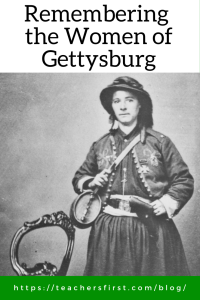The Battle of Gettysburg is widely recognized as a pivotal moment and turning point in the Civil War. From July 1 to July 3, 1863, the battle resulted in over 50,000 casualties. The Union’s victory thwarted the Confederate invasion of the North, influencing the war’s course. Notably, on November 19, 1863, Abraham Lincoln delivered the iconic Gettysburg Address at Gettysburg, dedicating the cemetery while reflecting upon the ideals of the United States as enshrined in the Declaration of Independence.
By examining the Battle of Gettysburg through the personal experiences of its participants, students gain a deeper understanding of the scale of death and suffering that occurred during this pivotal Civil War event. One approach to consider is highlighting the women who played an essential role during this time. Featuring women and their roles in the Civil War expands understanding by helping students understand the tremendous challenges and conflicts of the time that focus beyond a traditional military narrative featuring men.
The only civilian casualty at Gettysburg was a woman named Jennie Wade. Jennie was 20 years old and was kneading dough in her sister’s kitchen when a rifle bullet pierced two doors and claimed her life. After Jennie’s death, her mother made the dough into fifteen loaves of bread to distribute to Union soldiers.
Several resources featuring Jennie Wade and others offer interesting facts and information about the women of Gettysburg.
- Gettysburg by the Numbers (reviewed here) – Share this site with students to explore interesting facts about the soldiers, demographics, and more about the Battle of Gettysburg. Jennie Wade is mentioned on this site; ask your students to explore the site to find information about Jennie and then visit the provided link to learn more about Women at the Battle of Gettysburg.
- Stuff You Missed in History Class (reviewed here) – Podcasts are an excellent resource for students and typically provide information not found in textbooks. Fearless, Feisty, and Unflagging: The Women of Gettysburg shares the story of Marie Tepe, Elizabeth Thorn, and Mary Goldsboro, along with other women known for their contributions to the community and the battle.
- CamCoHistory’s “Women at the Battle of Gettysburg” – Listen to this presentation by Jane Estes to understand women’s underappreciated involvement as civilians and military personnel.
- The Gettysburg Experience – Visit this site to find many stories of the people of Gettysburg during the Civil War era. Unfortunately, the site has no search feature; however, visiting the archives allows users to find articles by title. Learn about Elizabeth Thorn, Anna Etheridge, Liberty Hollinger Clutz, and other women who dealt with these turbulent times.
- American Battlefield Trust (reviewed here) – Find several articles and classroom resources focusing on women in battle using the search term “women Gettysburg.” Discover the story of Mary Thompson, whose home sits close to the battlefield, and the disruption to her formerly peaceful life, or read the story of three famous vivandières, women serving in military regiments selling food and drink to soldiers to supplement their rations. These stories and others offer a look at the many different roles of women in support of the war.
Consider generating an introductory video about Gettysburg to engage students in learning using inVideo AI (TeachersFirst review). Write a clear and specific prompt that asks inVideo AI to create a video that discusses Gettysburg’s importance and the contributions made by women. This example uses the prompt, “Generate a 3-minute video about Gettysburg that focuses on the women of Gettysburg who played an essential role during this time. Include Jennie Wade, Marie Tepe, Elizabeth Thorn, Mary Thompson, and Mary Goldsboro. Be sure to include the significance of Gettysburg during the Civil War.”
The story of The Battle of Gettysburg goes beyond the military conflict itself. Exploring the experiences of women like Jennie Wade, Marie Tepe, and Elizabeth Thorn provides a more comprehensive understanding of the sacrifices and challenges faced by individuals and families during the Civil War than is offered by simple discussions of the battle’s effect on history. Sharing and discussing often overlooked perspectives enriches student learning, shares opportunities to appreciate the diverse voices that shaped our history, and encourages students to develop a deeper perspective of historical events.
Do you have any favorite resources and ideas for teaching about the Battle of Gettysburg from different perspectives? Share your thoughts in the comments below as we learn together.


